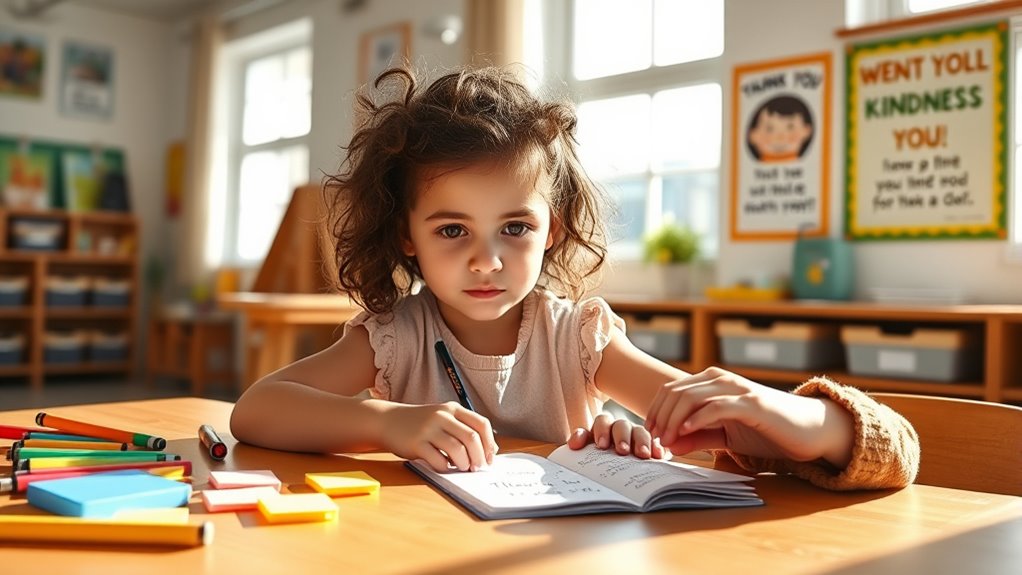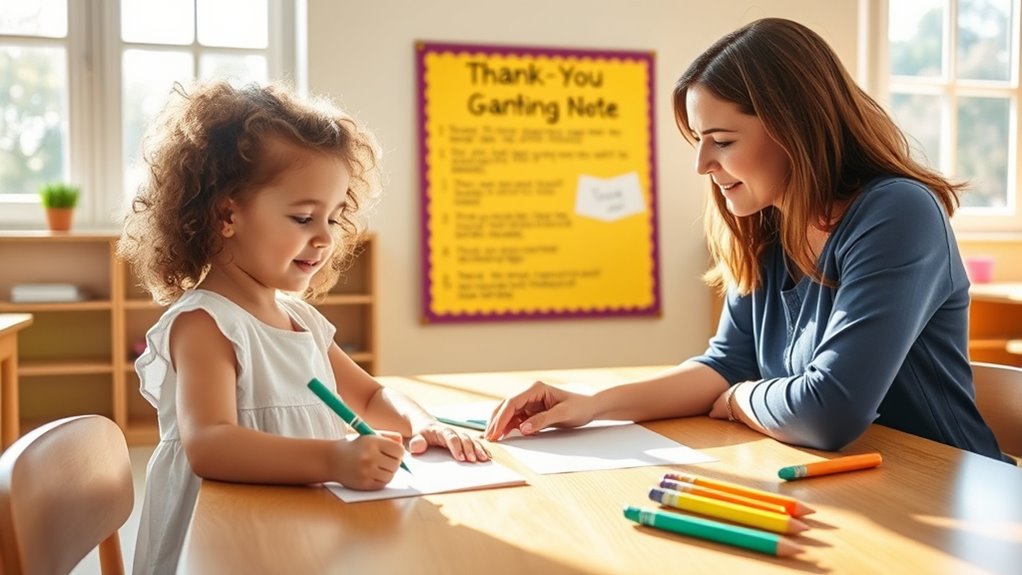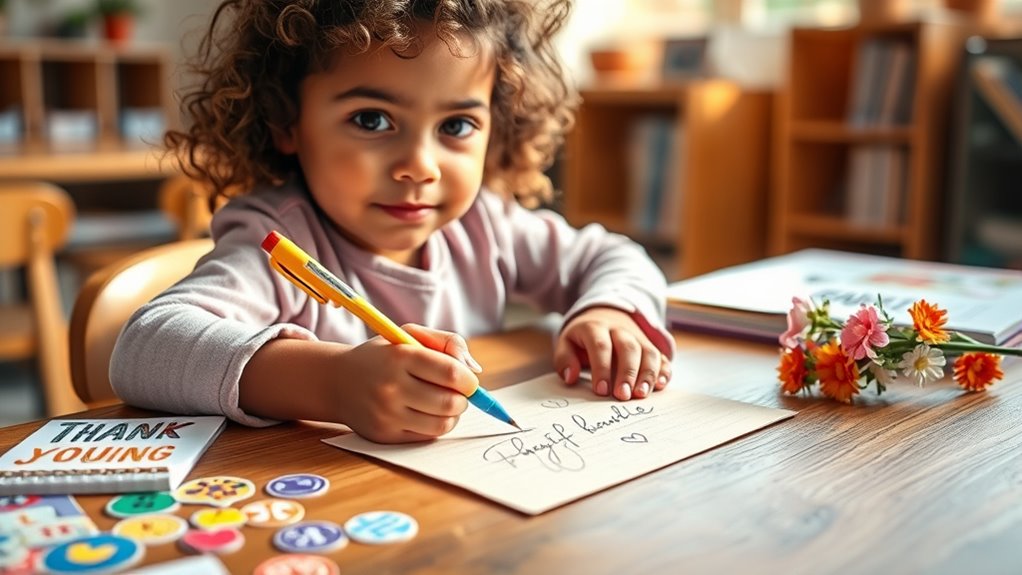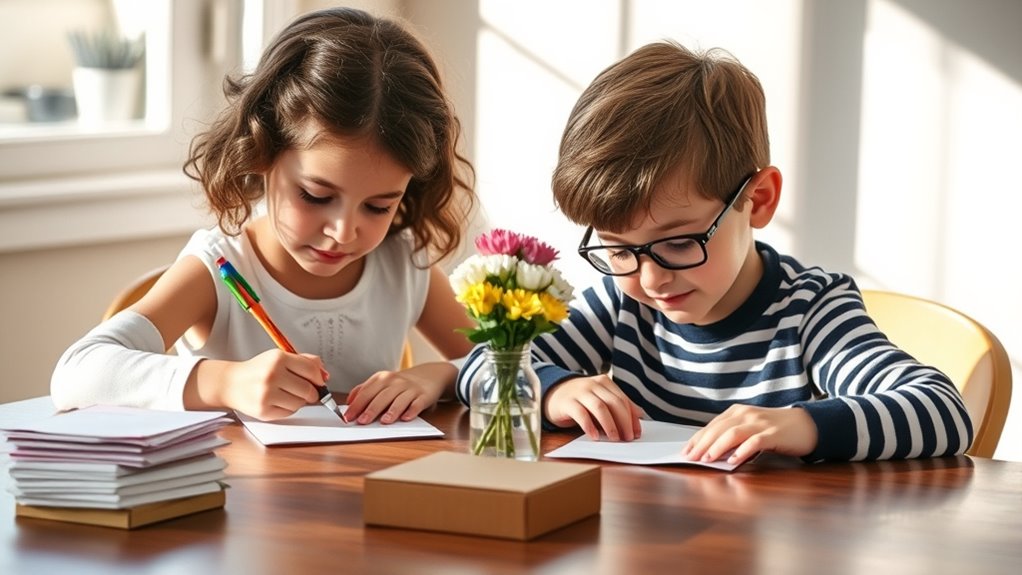Teaching kids to write thank-you notes helps them develop gratitude and social skills like kindness and politeness. Start early, around ages 5-7, by incorporating simple routines after gifts or special events. Encourage genuine, heartfelt messages with personal touches such as drawings or stickers. Use small, manageable steps to build confidence and celebrate progress to motivate them. If you keep practicing these methods, you’ll find effective ways to make gratitude and thank-you notes a natural part of their lives.
Key Takeaways
- Introduce thank-you notes through simple routines, like after gifts or special occasions, to build familiarity and confidence.
- Use creative materials and decorations to make writing notes engaging and personalized for children.
- Model proper etiquette and genuine gratitude by writing your own thank-you notes publicly or privately.
- Set small, achievable goals and celebrate progress to encourage consistent practice and boost confidence.
- Reinforce the importance of sincerity and effort, praising specific actions to nurture emotional intelligence and social skills.
Why Teaching Gratitude Matters for Kids

Teaching kids to express gratitude is important because it helps them develop empathy and appreciation for others. When children learn to recognize what they’re thankful for, they build emotional intelligence, understanding their feelings and the feelings of those around them. Gratitude fosters social skills by encouraging kindness, politeness, and positive interactions. These qualities help kids form strong relationships and navigate social situations more effectively. By teaching gratitude early, you’re helping your child become more empathetic and considerate, which benefits their personal development and social life. Cultivating gratitude isn’t just about saying “thank you”; it’s about nurturing a mindset that values others, creating a foundation for healthy emotional and social growth as they mature. Additionally, introducing concepts like color accuracy and contrast ratios can subtly enhance their understanding of visual details and appreciation for quality, fostering attention to detail and discernment in different aspects of life.
When and How to Introduce Thank-You Notes

You can start introducing thank-you notes when your child is around 5 or 6, depending on their reading and writing skills. Timing tips include fitting practice into daily routines like after meals or bedtime, making it a natural habit. Incorporate small, manageable tasks such as writing a quick note or drawing a picture to build consistency and confidence. Using crochet styles for locs or other creative crafts can also help develop fine motor skills essential for writing.
Suitable Age Range
At what age can children start learning to write thank-you notes? Typically, the appropriate age aligns with their developing learning milestones, usually around 6 or 7 years old. At this stage, kids begin to grasp basic writing skills and can understand the importance of expressing gratitude. You can introduce thank-you notes gradually, focusing on simple sentences and basic etiquette. Keep in mind, every child develops at a different pace, so observe their readiness.
Consider these points:
- Start with short, guided practice to build confidence.
- Use age-appropriate language and prompts.
- Focus on fostering genuine gratitude rather than perfection.
Family Timing Tips
When is the right time to introduce thank-you notes to your family routine? The key is to find a natural moment that fits your existing family routines, like after birthdays or holidays. Starting small helps with time management, so set aside a specific time, such as during a weekly family meeting or after dinner. Consistency is important, but don’t pressure your child; instead, model the behavior by writing thank-you notes yourself. You can also incorporate note-writing into other routines, like when kids receive gifts or acts of kindness. This approach helps your family see thank-you notes as a normal part of your life, making it easier for kids to develop the habit without feeling overwhelmed or out of place. Additionally, introducing self-watering plant pots as a metaphor for nurturing gratitude can subtly reinforce the importance of care and consistency in expressing thanks.
Daily Practice Ideas
Introducing thank-you notes into your child’s daily routine can be simple and effective when you choose small, consistent practices. Start by setting aside a few minutes each day for writing. Focus on developing handwriting techniques that promote neatness and confidence. Encourage your child to experiment with note design ideas, such as adding drawings or decorative borders, to make each note special. To keep it engaging, consider these practice ideas:
- Use themed stationery to inspire creativity.
- Incorporate fun handwriting drills to improve letter formation.
- Encourage personalized note design ideas that reflect the recipient’s interests.
- Incorporate decorative touches like stickers or embellishments to make the notes more charming.
Consistency helps build the habit naturally, making thank-you notes a meaningful part of your child’s daily life and communication skills.
Essential Components of a Thoughtful Thank-You Note

A thoughtful thank-you note includes several essential components that make it meaningful and sincere. First, proper etiquette etiquette is key; addressing the recipient with a warm greeting shows respect. Next, mention the specific gift or kindness you received, demonstrating appreciation and attentiveness. Your note should be handwritten handwriting, which adds a personal touch and shows effort. Keep your tone genuine and heartfelt, avoiding generic phrases. Be clear and concise, expressing how the gift or gesture made you feel. Finally, close with a friendly sign-off and your name. These components help your child understand what makes a thank-you note sincere and respectful, encouraging them to develop good manners and thoughtful communication skills. Incorporating best anime movies or animated stories can also inspire children to craft their notes with creativity and emotional depth.
Step-by-Step Guide to Writing a Thank-You Note

Wondering how to craft a perfect thank-you note? Start with a clear structure to guide you. Begin with a warm greeting, then express your gratitude for the specific gift by name, mentioning how you plan to use it. Keep your letter formatting neat and consistent, making sure your handwriting is legible or using a proper card. Be genuine and concise in your message, focusing on gift acknowledgments and the giver’s thoughtfulness. End with a friendly closing and your name. To elevate your note, consider these points:
- Use proper paragraph spacing and alignment
- Mention the gift specifically to personalize your message
- Keep the tone polite and enthusiastic
Following these steps helps your child write meaningful thank-you notes that show appreciation and good manners.
Creative Ideas to Make Thank-You Notes Special

Have you ever thought about adding a personal touch to your thank-you notes to make them truly stand out? Using crafty stationery can instantly elevate your message, making it feel more special. Let your child pick colorful or textured paper to add personality. Incorporate personalized stamps to create a unique design that reflects their interests or the occasion. These small details show thoughtfulness and effort, making the note memorable. You can also encourage your kid to decorate the edges with drawings or stickers, adding a creative flair. Combining crafty stationery with personalized stamps makes each thank-you note feel one-of-a-kind. Additionally, choosing cost-effective supplies can help you stay within budget while still creating beautiful notes. These simple ideas help kids understand the importance of sincerity and effort, turning thank-you notes into meaningful keepsakes for the recipient.
Tips for Encouraging Consistent Practice

Encouraging your child to practice thank-you notes regularly helps make writing heartfelt messages a natural habit. Consistent practice builds confidence and reinforces the importance of expressing gratitude. To foster practice consistency, establish a routine, like writing a note after special occasions or weekly. Use positive reinforcement to motivate your child, praising their effort and progress. You can also set small, achievable goals to keep them engaged. Incorporating leadership skills such as effective communication can help children articulate their appreciation more clearly and confidently.
Celebrating Success and Building Confidence

You can boost your child’s confidence by recognizing their genuine efforts and celebrating their progress. Sharing your own experiences of overcoming challenges shows them that growth takes time. When you celebrate milestones together, it reinforces their achievements and encourages continued effort. Incorporating positive reinforcement techniques can further motivate children to develop good habits and skills.
Recognize Genuine Efforts
How can you truly boost a child’s confidence? By recognizing genuine efforts and identifying sincere gestures, you show them their actions matter. When you acknowledge their hard work, not just the outcome, you reinforce positive behavior. This encourages kids to keep trying and improves their self-esteem. To do this effectively: – Praise the specific effort behind their actions, like their patience or creativity. – Celebrate small progress, not just big achievements. – Offer genuine, heartfelt compliments that highlight their sincerity. Incorporating positive reinforcement techniques can further strengthen their motivation and self-belief.
Share Personal Achievements
Sharing your own successes with kids can be a powerful way to boost their confidence. When you openly share your personal milestones and achievement sharing stories, you show them that everyone has goals and accomplishments. This encourages kids to recognize their own progress and feel proud of their efforts. For example, sharing stories about financial management and long-term planning can help children understand the importance of money and savings from a young age.
Here’s a simple way to model this:
| Personal Milestone | How I Achieved It | What I Learned |
|---|---|---|
| Learning to ride a bike | Practiced every weekend | Patience pays off |
| Finishing a big project | Broke it into steps | Stay organized |
| Running a race | Trained for months | Consistency matters |
Celebrate Milestones Together
Celebrating milestones together creates a joyful atmosphere that encourages children to feel proud of their accomplishments. Recognizing achievements, like completing a thank-you note or participating in holiday traditions, builds their confidence. You can mark these moments with simple gestures such as gift giving or special activities, making the experience memorable. Incorporate milestones into everyday routines to reinforce positive habits and foster a sense of pride.
- Acknowledge their efforts publicly or with a small reward
- Use holiday traditions to create meaningful celebrations
- Encourage children to share their success stories with family and friends
These approaches help children associate gratitude with celebration, making thank-you notes a natural part of their growth. Celebrating together turns small wins into meaningful learning experiences, boosting their motivation to succeed.
Frequently Asked Questions
How Can I Teach Kids to Personalize Their Thank-You Notes Effectively?
When teaching kids to personalize their thank-you notes, you encourage creative writing by prompting them to include specific details about the gift or experience. Help them express emotions honestly, making their notes heartfelt. You can suggest they think about how the gift made them feel or what they plan to do with it. This approach fosters emotional expression and makes each note unique, showing genuine appreciation.
What Are Age-Appropriate Examples of Thank-You Notes for Different Occasions?
This question is as important as finding a needle in a haystack! For different occasions, you should use thank you note etiquette with age-appropriate language. For young children, keep it simple and sweet, like “Thanks for the toy!” For teens, encourage more detail, like “Thanks for the amazing birthday gift. I love it!” Adjust your tone to match their understanding, making sure they learn the proper way to show gratitude at any age.
How Do I Handle Situations Where a Child Forgets to Send a Thank-You Note?
When a child forgets to send a thank-you note, you can use motivational strategies like gentle reminders and praise to encourage them. Make it a fun task by setting accountability partners, such as a sibling or friend, to remind each other. Explain why thank-yous matter, helping them understand the importance. Consistent encouragement and positive reinforcement will instill good habits, making future note-writing more natural and appreciated.
What Tools or Materials Are Best for Encouraging Kids to Write Thank-You Notes?
Think of writing thank-you notes as planting seeds of gratitude; the right tools help them grow. You should provide creative stationery that sparks their imagination and digital tools like kid-friendly writing apps to make the process fun. These materials turn a simple task into an adventure, encouraging kids to express thanks effortlessly. With colorful pens and engaging templates, you keep their enthusiasm alive, making gratitude a natural part of their daily lives.
How Can Parents Model Good Gratitude and Thank-You Note Writing at Home?
You can model good gratitude by practicing gratitude exercises regularly, like sharing what you’re thankful for at dinner. Incorporate family traditions, such as writing thank-you notes together after special occasions. When your kids see you genuinely expressing appreciation and writing thoughtful notes, they learn by example. This consistent modeling helps them understand the importance of gratitude and encourages them to develop their own thank-you note writing habits.
Conclusion
By teaching kids to write thank-you notes, you’re helping them develop gratitude and confidence. Imagine Emily, who once struggled to express herself, now happily writes heartfelt notes after receiving gifts. Encouraging this habit not only builds good manners but also boosts their self-esteem. Keep practicing together, celebrate their progress, and watch as they grow into thoughtful, appreciative individuals who understand the importance of kindness in everyday life.









